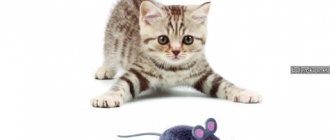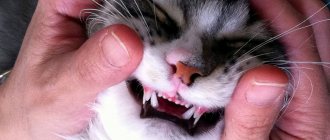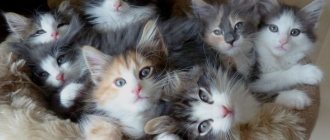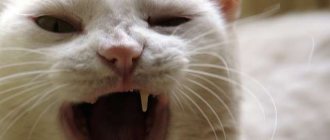During the period when kittens are born, the owner bears the responsibility of caring not only for the mother cat, but also for her fragile children. It is necessary to prepare a comfortable and safe place where newborns will be. And there are even more obligations when babies try to take their first steps. Accordingly, you need to know about how they grow and develop, when kittens begin to walk, and what problems may arise in connection with this. This will be discussed in this article.
Details of the development of cat paws
Cat's paws require special attention, since they are an important organ not only for movement, but also for the animal's senses.
A little about the structure of the limbs
The cat's front paws do not have a solid connection to the skeleton, but are connected to it through elastic and strong tendons. This anatomical feature is called a floating shoulder. Thanks to this, the animal has the ability to smoothly descend when jumping from a height. And that is why cats are able to walk quietly and imperceptibly, as if they were swimming, taking a sliding step.
Cat paws, at first glance, soft, can cause injury to the offender
The forelimbs of pets have five fingers. The claws grow from the last phalanx of the finger and are released only during hunting, fighting, or for climbing surfaces. The rest of the time they are hidden in the phalanges, and the paws are soft pads.
For your information! The exception is the first finger, which is located a little further from the rest. The claw on it does not retract.
As for the hind limbs, they, unlike the front ones, are rigidly attached to the sacrum, the paws are stronger. This is due to more stress on the back of the body. The animal strongly uses these paws when running or jumping. In this case, they serve as a kind of push and support for him. There are four toes on the hind legs.
Note! Some types of cats have a deviation in the number of fingers on their limbs - polydactyly or oligodactyly, when there are more or less fingers than normal. These defects are inherited.
Functions of cat paws
Cat paws are quite versatile. During evolution, they acquired the ability to perform various functions, thanks to which the animal managed to survive and adapt to living conditions:
- moving, touching, clinging to objects, climbing. Cats' paws are incredibly flexible, thanks to which animals can climb a tree or other tall object with enviable ease and move deftly along it. This allows them to be successful hunters;
- shock absorption when jumping, thanks to which they smoothly push off from the surface and also land on it;
- caring for your fur. They wash with their paw the places that their tongue cannot reach (muzzle, ears);
- tactile function. Check items for possible danger;
- hunting and self-defense. Sharp claws in their paws allow them to deftly catch prey and also defend themselves from enemies;
- food and drink. You can often see cats catching food and water with their paws. The reason for this may be a not very comfortable bowl, which the pet touches with its whiskers. In this regard, the animal experiences discomfort and uses its limbs;
- relaxation, relaxation. Moving your fingertips over the surface when the cat is calm and content;
- communication. Thanks to the sensitivity of the paws and the characteristic secretion of the glands that they produce.
Important! Since an animal's paws perform a number of vital functions, they must be subject to careful care and attention. The owner should inspect them more often to identify scratches, cuts, infections and foreign objects.
Cats' paws are their means of communication with humans
How to accustom a kitten to a bowl
When introducing a kitten to a bowl, you need to take into account the fact whether he lives with his mother or alone. If the pet is with its mother, then she will teach it everything necessary: to eat, to escape, to repel the enemy, to clean its fur. When a cat teaches a baby to feed, she clearly shows him how to lower his face into the bowl and what movements should occur. She chews food and swallows it. The mother, with her purring and appearance, calls the kitten to the bowl.
The baby's brain absorbs all information like a sponge. He can repeat all the actions. But in life this doesn’t always happen; sometimes the owner is forced to teach the kitten everything. It is worth remembering that a resident can not only learn feeding skills from a person, but also habits such as going to the toilet and brushing their teeth. The owner must begin training by personal example.
You should learn how to teach a small kitten to eat from a bowl on its own. It is necessary to demonstrate to the baby how to eat on the floor from a plate. If he doesn’t copy the behavior, they take him on his lap and the plate too. A cozy environment is important for cats; they love warmth. The food is smeared onto the pacifier or finger and offered to the pet. This way he will quickly remember how he ate his mother’s milk. When your pet licks the food, it will develop an appetite. The food is placed in a container for him to see. If he behaves absent-mindedly, it means he is not hungry or wants to sleep, so training is stopped.
Note! When the owner goes to the kitchen, he must say “let’s go eat.” After several attempts, the kitten will begin to remember these words; they will be associated with feeding
Another way to teach a kitten to eat on its own:
Lay a towel on the floor and place a bowl on it. The milk is heated to a temperature of 36 °C and poured in small portions into a container. The pet is placed near the plate and its nose is carefully dipped into the milk. If necessary, the process is repeated several times.
The third way to teach a kitten to eat on its own:
- Take a tablespoon of warm milk.
- They bring it to their mouth and let it taste.
- The spoon is held at the level of the muzzle, then the kitten will have no choice but to lick the milk.
Important! The sooner the process of introducing a kitten to a bowl and feeding itself begins, the faster it will master the necessary skills. Until your baby is one month old, you cannot teach him to eat from a bowl.
He is still weak and not strong enough. If a newborn kitten is left without a mother, then you need to offer him milk from a pipette, then a bottle with a nipple. A small pet should receive food often. As you get older, the number of feedings decreases
Until the baby is one month old, you cannot teach him to eat from a bowl. He is still weak and not strong enough. If a newborn kitten is left without a mother, then you need to offer him milk from a pipette, then a bottle with a nipple. A small pet should receive food often. As they get older, the number of feedings decreases.
Babies sometimes get into the bowl, no need to pull it back
The main stages of development of the motor system
When do kittens start going to the toilet on their own?
Developing the skills of a small kitten to walk confidently and run quickly takes place in several stages:
- A newly born kitten is helpless because it cannot not only walk, but also see and hear. They can only smell, since the sense of smell is highly developed.
- At the age of 1 day to five days, when the kittens’ eyes are not yet open, they try to move by crawling on their stomachs. A keenly developed sense of smell helps them move in the right direction. They find their mother by smell, trying to get closer to her, moving their weak paws along the floor.
- At the age of 5-10 days, kittens are already better oriented and quickly find the cat by smell, trying to actively work with their limbs, crawling on the floor.
- Between one and a half to two weeks, the babies' eyes open and they rise to their forelimbs. During the same period, the hind legs develop.
- Already at the age of two weeks, babies rise and stand on all their legs, trying to repeat everything after their mother, including walking. During this same period, it is very important to toilet train them. The babies' first steps are still uncertain: they stand on their paws for the first time and at the same time sway from side to side, falling onto their sides. In fact, this is the period of the first exercises to train muscles and joints.
- Three weeks of age is the period when kittens’ limbs finally develop, they no longer begin to crawl, but to walk, and even try to run and make their first attempts at jumping.
- At one month of age, the animal’s movements have already been honed and they are confident that they can fully control their body. During this period, kittens actively play with each other, run and jump.
When their eyes open
The process of eye opening in cubs of different breeds begins on the 5-9th day of life. Delays may occur if the baby was born weakened or the mother is not fed correctly.
Be sure to read:
Sex barrier for cats: release forms, dosage, course of administration, indications and contraindications
Experienced breeders know breed differences. Beginning cat lovers should know that girls' eyes open earlier. Babies of long-haired breeds mature later than short-haired ones.
If the baby is 2 weeks old and its eyes have not opened, it is recommended to moisten them with strong tea or diluted boric acid and try to move them apart. In case of failure, contact an experienced felinologist or veterinarian.
When do kittens start walking instead of crawling?
When do kittens start eating on their own?
For some time after birth, it is still quite difficult for a kitten to move: its legs are weak, and its eyes still cannot see. However, closer to 2.5-3 weeks, babies already develop vision and hearing, they go to the tray on their own, can eat on their own and do without their mother, and at the same time they try to move on their legs. Naturally, their first steps are still uncertain and weak. But after a week, the movements become more dexterous, the steps are confident, and the kittens happily jump and run.
Note! The time frame for when, how and how long kittens walk does not depend on the breed of the pet. This is affected only by his physical health and proper nutrition.
The kitten's first steps are still weak and uncertain
Does a kitten need a separate sleeping place?
Usually the cat chooses its favorite places to rest, so you should take a closer look at your pet’s habits and place a lounger exactly where he most often likes to take a nap. This is also convenient for the owner himself - it is easier to remove cat hair from only one place, and not from all surfaces in the house.
But sometimes it happens that kittens fall asleep in the most inappropriate places.
Do not rush to transfer the baby to his lounger. Perhaps he is still wondering if he likes his bed. If the kitten ignores the sleeping place specially purchased for it, you will have to give in to the wayward cub and allow it to sleep wherever it pleases.
Problems in limb development
A conscientious breeder or simply a good owner must monitor whether the kittens are developing correctly and take care of the completeness and safety of the conditions in which they live and grow.
When kittens open their eyes: how many days after birth
If by the end of 3 weeks the baby does not stand on its paws, then this may be a serious reason to seek help from a veterinarian. After all, weak limbs and accompanying pain are signs of certain pathologies, such as:
- musculoskeletal disorder;
- hip dysplasia;
- rickets;
- kidney diseases;
- oncological diseases;
- poisoning;
- various injuries.
Important! If any problems are detected, immediate consultation with a specialist will be required. There is no need to wait until the baby grows up, since wasting time will only aggravate the problem and harm his health.
Rickets in a kitten
Do you need a walker?
There's a difference between strollers, toy lawn mowers and carts that you push, and walkers that rely on a frame and seat to support your baby. Experts recommend avoiding such options – or better not using them at all, and here’s why.
Walkers suppress the desire to learn to walk independently. They are comfortable and, as it seems to the child, safe - so why learn to walk on your own?
Secondly, many children are able to move very quickly in walkers, and it is difficult to keep track of them. Here the child is here - and now he is at the hot stove, next to the threshold, over which he trips, or accelerates and bumps into the corner of the table.
Important!
When the baby begins to move independently - crawling, walking, inspect the house for safety. Get on all fours and walk around the entire apartment, looking at all the corners from the height of a child’s eyes: what you can hit, what you can pull towards yourself (wires, cords, tablecloth), what you can open and take out household chemicals or medicines, what crack you can stick your fingers into and pinch them there.
Photos used from Shutterstock
Features of caring for kittens that have just begun to walk
A caring owner understands what problems kittens may have when they begin to take their first steps. After all, many obstacles and dangers await them on this unknown path. Therefore, it is necessary to take care of their safety by observing the most common requirements:
- remove away all objects that could cause injury to the baby’s legs. These can be heavy stools and chairs that can fall on a kitten, a flower pot, or sharp, small objects, as well as wires, various chemicals (washing powders, cleaning products, etc.);
- make sure that the kitten does not jump on high surfaces at first, as this can harm weak legs, remove everything from the eyes that might attract it, tie up the curtains;
- If the flooring in your house is slippery, you should at least temporarily lay a short-pile carpet on it. This will protect the still uncertainly moving kitten from slipping and spraining its paw. The place for the small creature to move must be adapted to its needs;
- do not allow anyone to pick up a still fragile creature, especially children, who can harm the baby with their careless movements. It is necessary to explain to them how dangerous and painful this can be for the kitten. When the cat gets a little older, you need to teach children to hold it correctly in their hands;
- You should also be careful when moving around the room, because the baby can come up quietly and unnoticed, and there is a risk of stepping on his foot or pushing him unsuccessfully;
- Transportation during this period is also undesirable, since the musculoskeletal system has not yet fully formed. If it is necessary to show the kitten to a veterinarian, it is better to call one to your home. Visiting an animal clinic for children also means that there is a high probability of contracting an infectious disease.
A kitten needs to learn to walk in a safe environment.
When the kittens grow up and get stronger, they begin to explore the world. Having learned to walk, they encounter various obstacles on their way that can injure the animal. Only a responsible owner can create more comfortable conditions for them and keep them safe. Having shown his participation in the physical development of the baby, he will receive healthy and active pets in the future.
Ragdolls
Ragdoll takes any pose that the owner chooses for him.
Ragdolls are one of the most popular family breeds. They were specially bred to be affectionate, obedient and patient with their owners. These cats are suitable for families with children, especially small children.
The unique ability of these pets is to remain completely relaxed even during a tight hug. It’s not for nothing that the literal translation of their breed sounds like “rag doll.”
Prevention of constipation and diarrhea in kittens
If the owner prefers to feed his little furry with natural products, you need to make sure that the diet contains not only meat, but also vegetables and cereals - these menu components have a positive effect on intestinal motility. Older cats need to add a small amount of steamed bran to the minced meat, which contributes to the balanced functioning of the digestive system.
The diet should definitely include cereal dishes such as well-cooked rice and buckwheat porridge, thoroughly mixed with minced chicken. A stew made from vegetables stewed or boiled in a small amount of water is appropriate. Instead of water, you can use weak meat broth. For vegetables, you can take carrots, beets, pumpkin, or zucchini, cut into small cubes.
Some pets themselves are drawn to cucumber, cabbage, melon, or green peas. In these cases, you need to encourage their appetite and provide your beloved pet with these foods. After all, melons, along with fresh vegetables, help improve intestinal function and help overcome chronic constipation.
Kitten at 1 month: approximate height, weight, skills
A one-month-old kitten weighs on average 400–500 g. At this age, babies already move well, wash themselves, and sleep often, but little by little. They are attracted to anything on the floor that they can play with, so you need to make sure that dangerous objects are not mistaken for a toy. Small pets need to be picked up, caressed, and played with so that they get used to communicating with people.
By one month, kittens already have baby teeth. They can be given water to drink and the first complementary foods begin to be introduced. Canned meat for baby food or special food for kittens are suitable for this. During the same period, the first preventive treatment against parasites is carried out. Kittens are given anthelmintic drugs according to their weight and age.
What to feed a stray cat from the street
If the baby is not a month old, you need to:
- Finding a nursing cat is ideal. To do this, write an ad in a local group for cats on VK, FB or another social network. It is unlikely that they will give you a pet, but they may agree to shelter a kitten for a while. Promise to pick up the baby as soon as the need for milk disappears. You may have to pay.
- Buy special food for newborn kittens. It is sold in a veterinary pharmacy.
- Mix 2 tbsp. milk (preferably goat) with 2 raw yolks. Use this option as a last resort, since milk can cause diarrhea and eggs contain salmonella. Cow's milk is poorly absorbed by the cat's body, so nutritionists do not recommend it.
If the kitten is more than a month old, it can be given wet commercial kitten food or natural products. A cat is a predator, so make your baby meat puree from beef, poultry, or rabbit. If the cat is 1.5 months old, give minced meat with grated vegetables. From 2 months, meat can be cut into small pieces. You can feed him liver once a week. Do not give your kitten fatty foods (pork, lard), chicken bones, canned food, and smoked meats.
When to feed your baby
Newborn kittens need to be fed every 2 hours. To do this, place them on your tummy, place the bottle above your head, at a slight angle. The mixture should be warm, but not hot.
When the kitten is 11 days old, the periods between feedings can be extended to 3-4 hours. On day 12, the interval should be increased to 5-6 hours. From 4-5 weeks you can wean the kitten off the bottle. Give him the mixture in a bowl, gradually switch him to adult food.
4–5 months: adolescence
The nutrition of a growing pet should consist of kitten food, which contains substances necessary for normal development. It is recommended to feed animals about 5 times a day. By the end of the fifth month, a three-times-a-day diet is established.
The appearance of the kitten changes, its body increases in size, its muzzle and tail lengthen, and its paws stretch. The pet can already be mistaken for an adult cat, he plays less with toys, sleeps more and strives to communicate with people. At 5 months, the kitten’s baby teeth begin to fall out and permanent teeth begin to grow.










